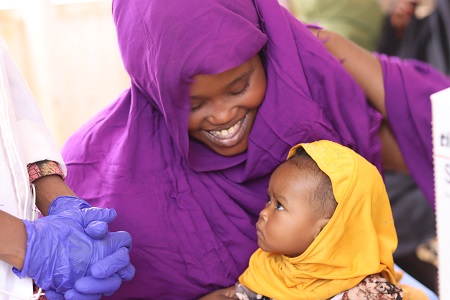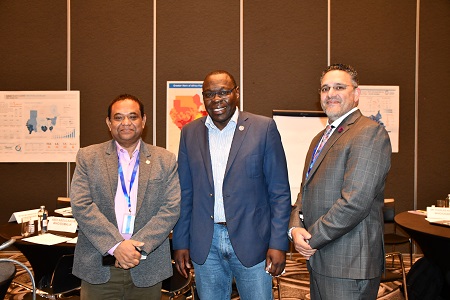 WHO is working to reach children with vital vaccinations. Around 7 million under-5s are acutely malnourished and have low immunity in the region. Credit: WHO Somalia28 August 2022 – In the greater Horn of Africa, famine is looming at the doorstep of many households. Over 80 million people in this region — which comprises Djibouti, Ethiopia, Kenya, Somalia, South Sudan, Sudan and Uganda — lack access to food that would meet their basic needs along with safe water. More than 37 million of these people have reached crossroads in their lives where they have had to sell their possessions to feed themselves and their families.
WHO is working to reach children with vital vaccinations. Around 7 million under-5s are acutely malnourished and have low immunity in the region. Credit: WHO Somalia28 August 2022 – In the greater Horn of Africa, famine is looming at the doorstep of many households. Over 80 million people in this region — which comprises Djibouti, Ethiopia, Kenya, Somalia, South Sudan, Sudan and Uganda — lack access to food that would meet their basic needs along with safe water. More than 37 million of these people have reached crossroads in their lives where they have had to sell their possessions to feed themselves and their families.
In this dire situation, the risk of morbidity and mortality due to outbreak-prone diseases comes in tandem with forced displacement. This is set against a backdrop of limited access to essential and primary health care interventions across the entire region. Each day, the most vulnerable populations, including children, pregnant and breastfeeding women, and displaced people, are facing growing threats of being infected with communicable diseases.
Outbreaks in the Region
The drought has exacerbated disease outbreaks in the Horn of Africa, a region that is constantly facing other emergencies, including the COVID-19 pandemic currently. Djibouti, Ethiopia, Somalia, South Sudan, Sudan and Uganda are experiencing measles outbreaks, while Kenya, Somalia and South Sudan are witnessing cholera outbreaks.
 WHO has supported nutrition stabilization centres to save the lives of children with severe acute malnutrition with medical complications. Credit: WHO/SomaliaThe countries also have high rates of severe acute malnutrition among children under 5 years old, all of which increase the risk of morbidity and mortality among displaced and vulnerable populations. Unless a coordinated response effort is implemented, health risks will keep escalating and spreading within and beyond the region.
WHO has supported nutrition stabilization centres to save the lives of children with severe acute malnutrition with medical complications. Credit: WHO/SomaliaThe countries also have high rates of severe acute malnutrition among children under 5 years old, all of which increase the risk of morbidity and mortality among displaced and vulnerable populations. Unless a coordinated response effort is implemented, health risks will keep escalating and spreading within and beyond the region.
Charting out plans for stronger collaboration
To continue to deter these severe health consequences of the drought in a coordinated manner in the greater Horn of Africa, the World Health Organization (WHO) convened a meeting from 26 to 27 June 2022 in Nairobi, Kenya, for the organization’s senior specialists and officials. These experts included Dr Ibrahima Socé Fall, WHO Assistant Director-General for Emergency Response, the WHO Representatives from the 7 countries of the region, and other technical expertise.
The participants set out to brainstorm ways to mount a stronger and coherent health response. They considered joint measures to improve primary health care interventions, including in the delivery of essential health services, nutrition support and immunization, communication and resource mobilization, and regional, inter-agency, and partner coordination. They also discussed the alignment of response plans, and health intelligence and information products and systems. After finalizing the Contingency Fund for Emergencies, an emergency fund run by WHO, the country teams also agreed on a series of next steps to take to advance recommended action.
Coordinating information management in the Region
 Dr Mamunur Rahman Malik, WHO Representative to Somalia, Dr Ibrahima Soce Fall, WHO Assistant Director-General for Emergency Response, and Mr Altaf Musani, WHO Director of Emergency Health Interventions, at a Greater Horn of Africa drought response meeting, Nairobi. Credit: WHO/SomaliaAs next steps, the information management teams from all 7 countries, and representatives from the WHO Regional Office for Africa, Regional Offfice for the Eastern Mediterranean and headquarters convened a meeting in Kenya from 25 to 27 July 2022. The team aimed to understand and document the information and data landscape across the region. They also discussed ways to enhance coordination using 4 health information management pathways – products, processes, people and tools – and the need for monitoring and evaluation, including on indicators related to nutrition, which is closely linked to health, and primary health care.
Dr Mamunur Rahman Malik, WHO Representative to Somalia, Dr Ibrahima Soce Fall, WHO Assistant Director-General for Emergency Response, and Mr Altaf Musani, WHO Director of Emergency Health Interventions, at a Greater Horn of Africa drought response meeting, Nairobi. Credit: WHO/SomaliaAs next steps, the information management teams from all 7 countries, and representatives from the WHO Regional Office for Africa, Regional Offfice for the Eastern Mediterranean and headquarters convened a meeting in Kenya from 25 to 27 July 2022. The team aimed to understand and document the information and data landscape across the region. They also discussed ways to enhance coordination using 4 health information management pathways – products, processes, people and tools – and the need for monitoring and evaluation, including on indicators related to nutrition, which is closely linked to health, and primary health care.
Following an analysis of all the different information collection tools and siloed, donor-driven individual disease management systems in the 7 countries, the participants agreed on the need to integrate health information management assets in the countries into a single cohesive integrated system.
In conclusion, the team agreed to create a joint situation report every month – that combines an epidemiological bulletin, known as the EPI watch, and a visually appealing infographic on the drought situation. They also agreed to create a general dashboard that shows drought response activities for each of the 7 countries. It will present information on malaria activities, cholera, interventions by community health workers, outreach interventions, and severe acute malnutrition stabilization centres in drought-affected areas.
Regional and country appeals for support
To scale up the response to the situation in the greater Horn of Africa, on 2 August 2022, WHO launched an appeal for US$ 123.7 million. The response will focus on 5 pillars: coordination and collaboration; surveillance and information; outbreak prevention and control; essential nutrition actions; and essential health services.
In Somalia, WHO launched an emergency health response plan for the ongoing drought in May 2022. With an ask of US$ 35 million until the end of 2022, the plan aims to strengthen disease surveillance, integrate nutrition programmes horizontally into health service delivery, and ensure adequate coverage levels of measles and polio vaccination, including vitamin A and deworming. Additionally, the plan will ensure the delivery of essential package of health services with nutrition and mental health and psychosocial support integrated in activities. To cater for the needs of young children and women, the response would also address integrated management of childhood illnesses and reproductive health.
“Since early last year, in Somalia, our urgent attention has focused on anticipating and averting severe health consequences of drought. We advocated for early action for the drought response to avoid regret, and for flexible and urgent funding to support our efforts. Since then, we have left no stone unturned to work towards preventing avoidable morbidity and mortality linked to epidemic-prone diseases, caused by limited access to safe water, food, proper sanitation and hygiene. In many ways, we have managed to avert large-scale losses of life, but even one life lost is too many,” said Dr Mamunur Rahman Malik, WHO Representative to Somalia.
Partnerships at WHO levels and with donors saving lives
Commenting on the extraordinary efforts to improve partnerships within WHO, Dr Malik, the WHO Somalia Head of Mission said, “Across the greater Horn of Africa, WHO is ramping up its response, improving coordination, and streamlining existing efforts and optimizing on resources to ensure we reach more people with life-saving support. With one million displaced Somalis, we have one million and more reasons to redouble our efforts and extend additional support to affected families.”
He added that the support from partners such as the European Union (EU) Delegation to Somalia, European Civil Protection and Humanitarian Aid Operations of Somalia, donors contributing to the Contingency Fund for Emergencies, and Gavi - the Vaccine Alliance, WHO has already been able to impact the lives of some of the hardest hit people.
For additional information on the appeals launched by WHO for the greater Horn of Africa and Somalia to respond to the ongoing drought:
Contingency Fund for Emergencies (who.int)
Contributions and allocations (who.int)


